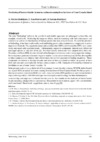Please use this identifier to cite or link to this item:
https://accedacris.ulpgc.es/jspui/handle/10553/114180
| Title: | Monitoring of booster biocides in marine sediments coming from harbours of Gran Canaria Island | Authors: | Sánchez Rodríguez, Á. Sosa Ferrera, María Zoraida Santana Rodríguez, José Juan |
UNESCO Clasification: | 2510 Oceanografía 251001 Oceanografía biológica |
Issue Date: | 2014 | Conference: | IV Congress of Marine Sciences | Abstract: | The term “biofouling” refers to the growth of undesirable organisms on submerged surfaces like, for example, vessel hulls. Biofouling has negative effects, such as increasing both fuel consumption and corrosion as well as the introduction of foreign species into new ecosystems. To avoid the presence of biofouling, it has been traditionally used antifouling paints which contain toxic compounds as active ingredient. From the 70s, organotin compounds as tributyltin (TBT) and triphenyltin (TPT) were exten- sively employed with excellent results. Unfortunately, organotin compounds showed toxic effects for non-target species at very low levels. For these reason, restrictions were adopted about their use. Nowadays and from 2008, it is not allowed sail in European community waters using organotin coatings. In consequence, paint manufacturers began to employ copper components as principal biocides together to other compounds to enhance their effectiveness for the full spectrum of fouling organisms. These compounds are known as booster biocides and most of them are found to inhibit the growth of both fresh and seawaters autotroph. In fact, some countries as UK, Denmark or Sweden have limited or forbidden the use of some booster biocides. In the present work we study the levels of four common booster biocides (diuron, TCMTB, dichlofluanid and irgarol 1051) in marine sediments coming from harbours of Gran Canaria Island. For this purpose, a microwave assisted extraction (MAE) and solid phase extraction (SPE) purification and preconcentration step combining with LC-MS/MS technique was employed as methodology for their determination. A monitoring campaign was conducted for one year and five months in five harbours of Gran Canaria Island, including fishing harbours and marinas. Measurable levels of diuron, irgarol 1051 and dichlofluanid were found. These levels ranged from units to tens of ng/g. | URI: | https://accedacris.ulpgc.es/handle/10553/114180 | ISBN: | 84-697-0471-0 | Source: | Book of Abstracts submitted to the IV Congress of Marine Sciences. Las Palmas de Gran Canaria, June 11th to 13th 2014, p. 301 |
| Appears in Collections: | Póster de congreso |
Page view(s)
56
checked on Nov 1, 2024
Download(s)
16
checked on Nov 1, 2024
Google ScholarTM
Check
Altmetric
Share
Export metadata
Items in accedaCRIS are protected by copyright, with all rights reserved, unless otherwise indicated.
